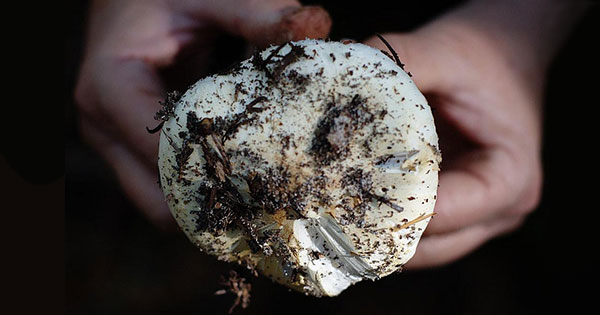The Mushroom at the End of the World
An excerpt from Anna Lowenhaupt Tsing’s new book about life in ecological crisis

In the aftermath of the atomic bombing of Hiroshima, as the story goes, the first new thing to grow was the matsutake. This unassuming mushroom—an off-white specimen with traditionally rounded cap—lacks the brilliant hues and exotic headgear of its mycological kin, but fetches up to $2,000 a kilogram in Japan.
The matsutake is the eponymous fungus of Anna Lowenhaupt Tsing’s new book, The Mushroom at the End of the World: On the Possibility of Life in Capitalist Ruins. For Tsing, the matsutake and its entangled network of foragers, traders, and buyers are a global system that thrives on the precarious margins of society. It’s an economic case study for the Anthropocene: the story of a profitable species that survives in the ecological wreckage that unchecked capitalism created.
In 1989, a plastic spotted owl was hung in effigy on an Oregon logging truck. Environmentalists had shown that unsustainable logging was destroying Pacific Northwest forests. “The spotted owl was like the canary in the coal mine,” explained one advocate. “It was … symbolic of an ecosystem on the verge of collapse.” When a federal judge blocked old-growth logging to save owl habitat, loggers were furious; but how many loggers were there? Logging jobs had dwindled as timber companies mechanized—and as prime timber disappeared. By 1989, many mills had already closed; logging companies were moving to other regions. The eastern Cascades, once a hub of timber wealth, were now cutover forests and former mill towns overgrown by brush.
What emerges in damaged landscapes, beyond the call of industrial promise and ruin? By 1989, something else had begun in Oregon’s cutover forests: the wild mushroom trade. From the first it was linked to worldwide ruination: The 1986 Chernobyl disaster had contaminated Europe’s mushrooms, and traders had come to the Pacific Northwest for supplies. When Japan began importing matsutake at high prices—just as jobless Indochinese refugees were settling in California—the trade went wild. Thousands rushed to Pacific Northwest forests for the new “white gold.” This was in the middle of a “jobs versus the environment” battle over the forests, yet neither side noticed the mushroomers. Job advocates imagined only wage contracts for healthy white men; the foragers—disabled white veterans, Asian refugees, Native Americans, and undocumented Latinos—were invisible interlopers. Conservationists were fighting to keep human disturbance out of the forests; the entry of thousands of people, had it been noticed, would hardly have been welcome. But the mushroom hunters were mainly not noticed. At most, the Asian presence sparked local fears of invasion: journalists worried about violence.
A few years into the new century, the idea of a trade-off between jobs and the environment seemed less convincing. With or without conservation, there were fewer “jobs” in the 20th-century sense in the United States; besides, it seemed much more likely that environmental damage would kill all of us off, jobs or no jobs. We are stuck with the problem of living despite economic and ecological ruination. Neither tales of progress nor of ruin tell us how to think about collaborative survival. It is time to pay attention to mushroom picking. Not that this will save us—but it might open our imaginations.
Reprinted with permission from The Mushroom at the End of the World, by Anna Lowenhaupt Tsing, published by Princeton University Press. © 2015 by Princeton University Press. All rights reserved.

